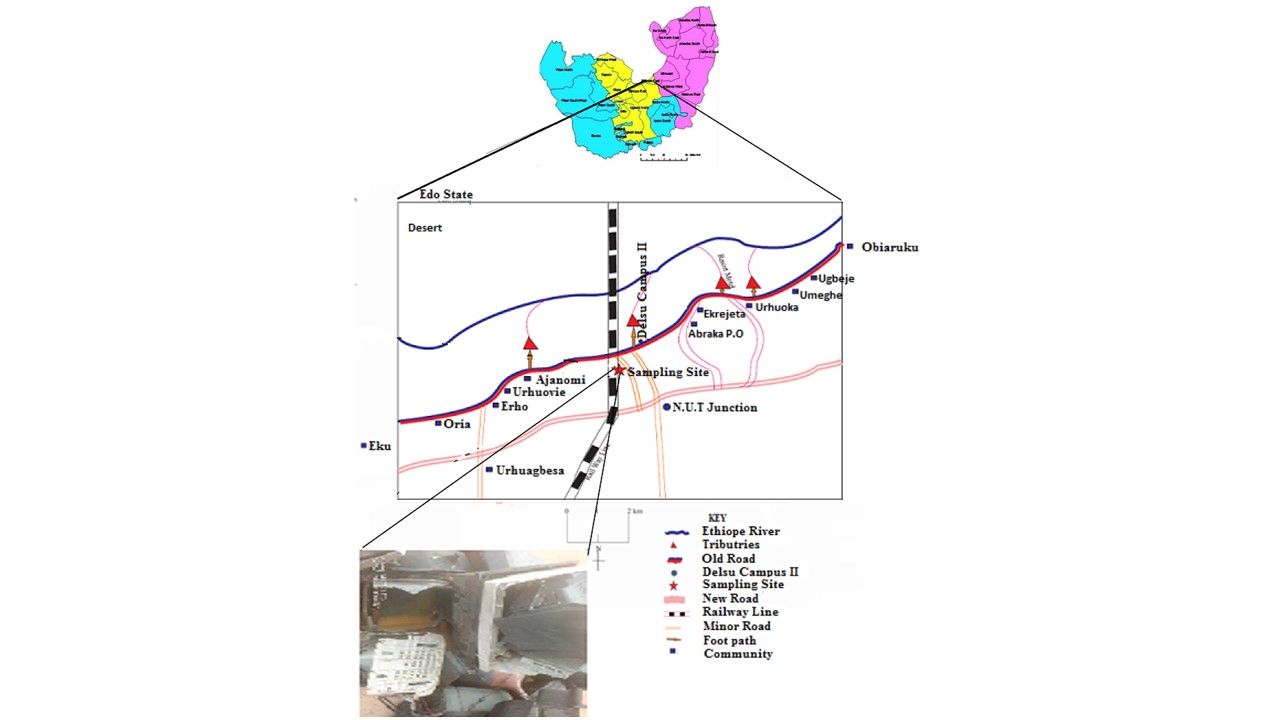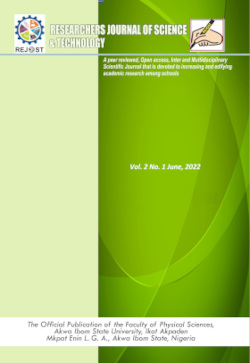Evaluation of Polycyclic Aromatic Hydrocarbons (PAHS) Levels in Soil Contaminated with Electronic Waste (E-Waste), South-Eastern, Nigeria
Keywords:
E-Waste, Polycyclic Aromatic Hydrocarbon, Dump Site, Contamination, Cancer riskAbstract
E-waste is an emerging environmental problem, as it is composed of a heterogeneous mix of different metals, metalloid, glass and plastic, which are useful and hazardous to the environment. The article aimed at evaluating the levels of Polycyclic Aromatic Hydrocarbons (PAHs) in soil contaminated with e-waste obtained at different depths (0 – 10 cm, 10 – 20 cm & 20 – 30 cm) and the evaluation was done in soil samples with the help of gas chromatograph coupled with a mass analyzer. The concentrations of the 16 Polycyclic Aromatic Hydrocarbons ranged from 404 – 32, 250 µg/kg, There was significant variation in the mean values of the 16 PAHs under study across seasons. At 0 – 10 cm in the dry season, the mean values ranged from 30.0 µg/kg (benzo(k)fluoranthene) High Molecular Weight (HMW) PAHs to 1,675 µg/kg (acenanphthylene) Low Molecular Weight (LMW) PAHs. While in wet season, it ranged from non detectable limit (naphthalene) LMW PAHs to 3,934 µg/kg (phenanthalene) LMW PAHs. The trend of PAHs percentage distributions was 3-rind PAHs > 7-ring PAHs > 2-ring PAHs > 4-ring PAHs > 5-ring PAHs > 6-ring PAHs. The hazard index HI-non carcinogenic risk for children was > 1 and for adult is < 1. The trends of ILCR concentrations for both children and adults follow ingestion > dermal > inhalation. The PAHs cancer risk in this study revealed moderate to very high level. It can be concluded that the e-waste dumping activities have contributed contaminant of PAHs to the soil. Hence dumping activates should be properly monitored.
References
Adebola, A. A. and Peter, O. (2017). Heavy metals and polycyclic aromatic hydrocarbons in soil from e-waste dumpsites in Lagos and Ibadan, Nigeria. Journal of health and pollution, 7 (15): 71 – 84.
Aliveira, R. F., Varandas, F. and Arbilla, G. (2014). Characterization of polycyclic aromatic hydrocarbons levels in the vicinity of a petrochemical complex located in a densely populated area of Rio de Janeiro, Brazil. Aunos Pollution Research, 5 (1): 87 – 95
Cao, W., Yin, L., Zhang, D., Wang, Y., Yuan,J., Zhu, Y. and Dou, J. (2019). Contamination, sources, and health risk associated with soil PAHs in Rebulh Land from a Coking Plant, Beiging, China. International Journal of Environmental Research Public Health, 16, 4.
Chukwujindu, M.A.I, Grace, O., Stephen, A. U, Francis, E. E., Eze, W. O., Godswill, O. T., Godwin, E. N. and Bice, S. M. (2019). Distribution, sources and risk exposure to polycyclic aromatic hydrocarbons in indoor dust from electronic repair workshop in Southern Nigeria. Emerging Contaminants, 5: 23 – 30
Dong, T. T. T., & Lee, B. K. (2009). Characteristics, toxicity and source apportionment of polycyclic aromatic hydrocarbons (PAHs) in road dust of Ulsan, Korea. Chemosphere, 74, 1245-1253.
Emoyan, O. O. (2020). Quantification and cancer risk evaluation of polycyclic aromatic hydrocarbons in soil around selected Telecom Masts in Delta State, Nigeria. Egyptian Journal of Chemistry, 63 (2): 433 – 448.
Eyenubo, O. B., Peretomodea, V. O., Egharevba, F., Osakwe, S. A.and Avwioro, O. G. (2014). Polychlorinated biphenyls (pcbs) in sediments and fish from dredged tributaries and creeks of river ethiope, south-south, Nigeria: sources, risk assessment and bioaccumulation, 6, 1 – 8, DOI:10.46481/jnsps.2024.1951.
Eyenubo, 0. B., Augustine, A., Osakwe S, A. and Egharevba F. (2022). Assessment of pollution potentials and chemical interaction of polybrominated diphenyls ethers on soil and bitter leaf around dumpsite in Abraka. Nigeria. Nigeria Journal of Pharmaceutical and Applied Science Research, 11 (2): 9 – 18.
Guo, H., Lee, S.C., Ho, K.F., Wang, X.M., &Zou, S.C. (2003).Particle-associated polycyclic aromatic hydrocarbon in urban air of Hong Kong. Atmospheric Environment, 37, 5307-5317
Iwegbue, C. M. A., Bassey, F. I, Tesi, G. O., Overah, L. C., Onyeloni, S. O. and Martincigh, B. S (2014). Concentration and health risk assessment of metals in chewing gums, peppermint and sweet in Nigeria. Journal of Food Measurement and Characterization, DOI 10.1007/s11694-9221-4
Iwegbue, C. M. A., Tesi, G. O., Overah, L. C., Emoyan, O. O.,Nwajei, G. E., & Martincigh, B. S. (2017). Effects of flooding on the sources, spatiotemporal characteristics and human health risks of polycyclic aromatic hydrocarbons in flood plain soils of the lower parts of the River Niger, Nigeria. Polycyclic Aromatic Compounds. https://doi.org/10.1080/-10406638.2017.1403329.
KhadiJah, A. I. (2016). Environmental Risk Assessment for an informal recycling site in Lagos State, Nigeria Middlesex University research at http://emprints, mdx.ac.uk/22233/
Liu, H., Yu, X. L., Liu, Z. R. and Sun, Y. (2018). Occurrence, characteristics and sources of polycyclic aromatic hydrocarbons in arable soils of Berging, China. Ecotoxicology and environmental safety, 159 : 120 – 126.
Liu, W., Ma, L., Abuduwaili, J., & Li, Y. (2017). Distribution,source analysis, and ecological risk assessment of polycyclicaromatic hydrocarbons in the typical topsoil of theIssyk-Kul Lake Basin.Environmental Monitoring andAssessment, 189, 398.https://doi.org/10.1007/s10661-017-6113-1.
Luo, X.S., Ding, J., Xu, B., Wang, Y.J., Li, H.B., & Yu, S., (2012). Incorporating bioaccessibility into human health risk assessments of heavy metals in urban park soils, Science of the Total Environment, 424, 88–96.
New York State Department of Health (NYS DOH) (2007). Hopewell precision area contamination. Appendix C-NYS DOH, In: Procedure for evaluating potential health risk for contaminants of concern. http://www.health.ny.gov/environmental/investigations/hopewell/appendc.htm
Panatda, P., Siriuma, J. and Supabhorn, Y. (2023). Soil heavy metal pollution from waste electrical and electronic equipment of repair and junk shops in southern Thailand and their ecological risk. National Library Medicine, 9(10): e20438. doi: 10.1016/j.heliyon.2023.e20438
Richard, A.O., John, K.B. and Stephen, O. (2013). Assessment of soil contamination through e-waste recycling activities in texma community one environment pollution, 2(2), 210-215.
Robinson, B. A. (2009). E-Waste: An assessment of globral production and environmental impacts. Science of the Total Environment. 408: 183-191.
Shengtao, M., Meiqing, L., Jian, T., Ranran, L., Yan, Y., Yingxin. Y., Guiying, L. and Taicheng, A. (2021). Occurrence and fate of polycyclic aromatic hydrocarbons from electronic waste dismantling activities: A critical review from environmental pollution to human health. Journal of Hazardous Materials, https://doi.org/-10.1016/j.jhazmat.2021.127683
USDOE (United State Department of Energy). (2011). The risk assessment information system (RAIS); U.S. Department of Energy’s Oak Ridge Operation office (ORO): Oak Ridge, TN, USA.
USEPA (United States Environmental Protection Agency). (1989). Risk Assessment guidance for superfund, Vol. 1: Human health Evaluation Manual EPA/se0/1-89/002, office of solid waste & emergency Response, Washington, DC.
USEPA (United States Environmental Protection Agency) (2001). Risk assessment guidance for superfund. Volume 1: Human evaluation Mannual (Part E, Supplemental guidance for defined risk assessment. EP/540/R/99/005.7. Washington, DC, USA: Office of Emergency and Remedial response, United State Environmental Protection Agency.
Wang, X. T., Miao, Y., Zhang, Y., Li, Y. C., Wu, M. H., & Yu,G. (2013). Polycyclic aromatic hydrocarbons (PAHs) in urban soils of the megacity Shanghai: Occurrence, source apportionment and potential human health risk. Science ofthe Total Environment, 447: 80–89.
World Bank (2014). Life expectancy data. Retrieved on May 2, 2014 from http://data.worldbank.org/indicator/SP.DYN.LE00.IN
Xi, C., Nuerla, A., Yusuyunjiang, M., Naifu, Z., Wenhu, C., Nanxin, L., Qlongfang, Z. and Miao, P. (2022). Pollution levels, sources and risk assessment of polycyclic aromatic hydrocarbons in farmland soil and crops, near Urumgui Idustrial Pak, Xinjiang, China. Research square, 1 : 1- 17.

Downloads
Published
How to Cite
Issue
Section
License
Copyright (c) 2024 Researchers Journal of Science and Technology

This work is licensed under a Creative Commons Attribution-NonCommercial-NoDerivatives 4.0 International License.




